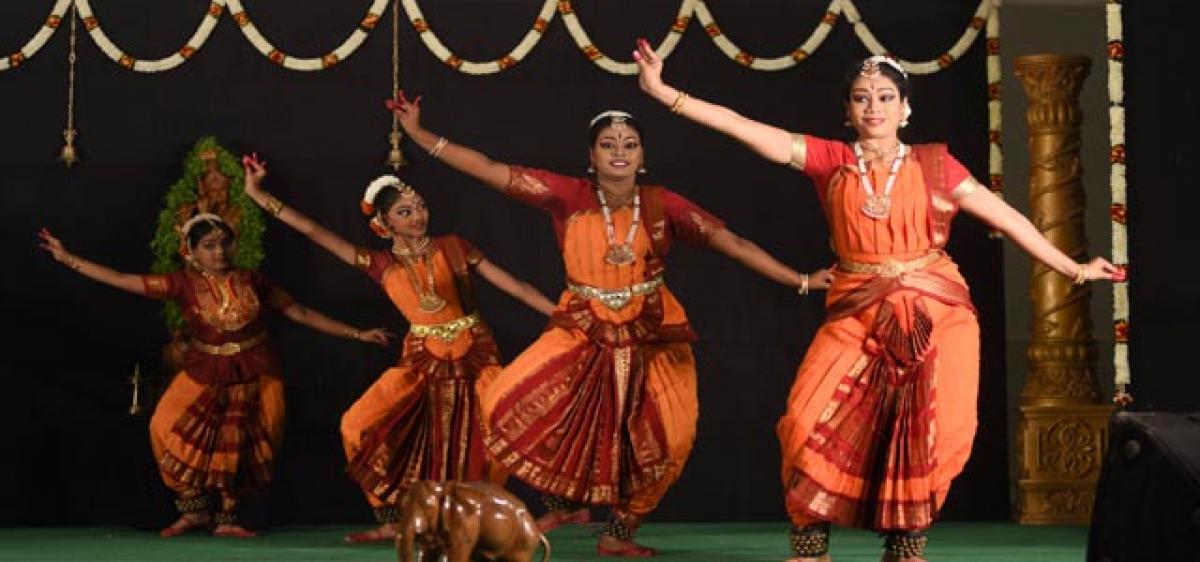Live
- CM Atishi inaugurates flyover
- Kejriwal's New Delhi constituency: Atishi accuses BJP of distributing cash to voters
- LHMS, a boon for people
- Sushmita Sen is ready for 2025 with ‘new look’
- Here’s why Triptii Dimri likes gorging on ‘Indian thali’ abroad
- Parenting Tips for parents: Creating a focused study space
- Australia’s warm tradition of family get-together at MCG
- Atal Bihari Vajpayee birth anniversary celebrated
- Junior National Equestrian: Anupati, Raju emerge winners
- Martina clinches silver at Asian Jr Weightlifting Championships
Just In

Natya Swara regaled audiences with \"Sukalpa - Elysian Exchanges in Music and Dance\" pioneered by Chitravina N Ravikiran in collaboration with noted Bharatanatyam dancer Smitha Madhav at Kalinga Cultural Centre Auditorium on Sunday.
Natya Swara regaled audiences with "Sukalpa - Elysian Exchanges in Music and Dance" pioneered by Chitravina N Ravikiran in collaboration with noted Bharatanatyam dancer Smitha Madhav at Kalinga Cultural Centre Auditorium on Sunday.
While there have been several dance jugalbandis and music duets in the last few decades, music-dance jugalbandis are uncommon and collaborations between instrumental music and dance almost unheard of. This is understandable since the absence of lyrics in instrumental music is perceived as a challenge by dancers. However, this first-of-a-kind mélange between Ravikiran on the 'singing instrument' chitravina and Smitha Madhav was a novel attempt to bring together the two scintillating disciplines together.
The musician-dancer duo presented a carefully chosen selection of compositions, which ensured ample scope for display of ‘nritta’ and ‘abhinaya’ even as the Carnatic concert format was kept intact. Even more noteworthy was how creative aspects like “kalpana”, “swaras” and “tanam” were handled by both Ravikiran and Smitha.
The opening piece was the bright Purandara Dasa composition, "Jaya jaya jaya janaki kanta" in Nattai capped off with sparkling swara exchanges. The way in which Smitha's feet were able to reproduce able to reproduce Ravikiran's intricate mathematical patterns showcased her own musicianship as a concert level vocalist. The climactic cadenza (korvais) executed in perfect unison by both along with mridangist Peravalli Jayabhaskar ensured a grand finish to the piece.
The next was Oottukkadu Venkata Kavi's Sanskrit masterpiece, “Madhava hrdi khelini” in Kalyani. Ravikiran mentioned that this was one of the "saptaratna krtis" of the great composer with Pallavi, Anupallavi and several charanams set as swaras and fast-paced lyrics, which scholars believe to be a fore-runner to the Tyagaraja Pancharatnas.
Smitha added that this was one of the few Carnatic pieces entirely centered on Radha. Presented gracefully, Smitha's keen perception of the nuances of music and the Ravikiran's own genius as a vaggeyakara ensured that the lyrics were "heard" through the dance and "seen" through the chitravina.
The central piece was Annamacharya's evergreen "Alarulu kuriyaga" in Shankarabharanam, where the playful antics of an amorous Alamelu manga came alive with élan through the song and also in the kalpana swaras. This was preceded by a majestic alapana by Ravikiran as a musical solo and rounded off with a tani avartanam by Jayabhaskar.
Oottukkadu Venkata Kavi made another appearance in the concluding number through his Sindhubhairavi Tillana and rightly so as he is considered as probably the first composer to have introduced this form to music and dance. A few passages were sung by Ravikiran to highlight the sahitya bhava, which enhanced the abhinaya experience. The programme was graced by senior playback artiste of yesteryears Rao Balasaraswati and Dr K Vishwanath.
By Anna Rao

© 2024 Hyderabad Media House Limited/The Hans India. All rights reserved. Powered by hocalwire.com







